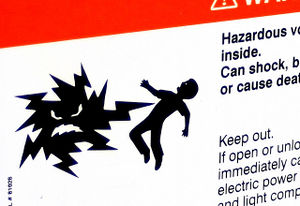Shock hazard

A shock hazard is the potential electric shock to a person that can be caused by many circumstances. It occurs when there is a voltage difference that a person may come into contact with. For example, if the person is standing on the ground which is at 0 V, any conductor at a given voltage they come into contact with (a faulty electric circuit, for example) may cause an electric current to flow through their body. It is the current that causes the damage, not the voltage, as a bird can sit on a high voltage power line with no damage. Of course a large voltage difference will lead to a current flowing. A saying goes:[2]
The mils here means "milliamps": at a current of just 1 mA (1/1000th of an Amp), the human body begins to feel a shock. At just 10 to 20 times this, the person experiencing the shock experiences the "can't let go!" phenomena where their muscles contract beyond their control. Anywhere above 100 mA may be fatal.[3]
Internal body resistance is typically very high - thousands of ohms - however only a small current is required to cause harm.[3] By Ohm's law, if the voltage increases while the resistance is the same, the current will increase as well. This is why relatively low voltages are required in a home or building in order to minimize the shock hazards.
Severity and Prevention
The severity may vary drastically depending on how conductive the person is. Typically skin isn't a good conductor, however if it is sweaty its resistance can be lowered by a large amount, causing a normally "safe" voltage to become lethal. Resistance also drops significantly if the person has a cut, blood conducts electricity quite well. The actual harmful damage occurs when current passes through the heart or other organs, which are more conductive than skin.[2]
Wearing insulated shoes or standing on a plastic bucket or wooden ladder may prevent the connection to the ground, providing safety from a potential shock.[2] People working with electricity are often told to keep one hand in their pocket, as a way to keep an electrical path from going through the heart. Another additional safety method used by electricians when touching a potentially harmful component is to ground a part of their hand. This causes a low-resistance path to form between the component and their grounded hand, and the damage will not reach their internal organs. Also, because of muscular contraction it is best to touch a component with the back of one's hand to avoid the clasping of the component. If someone is clasped onto a component and being electrocuted do not grab onto them or you may end up in their unpleasant situation; it is best to remove them using an insulator like a wooden stick, however kicking them off will do the job safer than grabbing onto them.[2]
Areas like substations and the tops of utility poles are dangerous and should only be entered by trained professionals. Downed electrical wires should also be reported to emergency services immediately.
Visit Hyperphysics for more information on shock hazards and the effects of shocks.
For Further Reading
For further information please see the related pages below:
- Ground fault circuit interrupter
- Circuit breaker
- Electric current
- Insulator
- Or explore a random page!
References
- ↑ lucianvenutian, Flickr [Online], Available: https://www.flickr.com/photos/lucianvenutian/880467001
- ↑ 2.0 2.1 2.2 2.3 A. von Meier, "Electric Shock," in Electric Power Systems, Hoboken, NJ: Wiley, 2006, ch. 1, sec.3, pp.13-14
- ↑ 3.0 3.1 Hyperphysics. (August 4, 2015). Electric Shock Hazards [Online], Available: http://hyperphysics.phy-astr.gsu.edu/hbase/electric/shock.html

